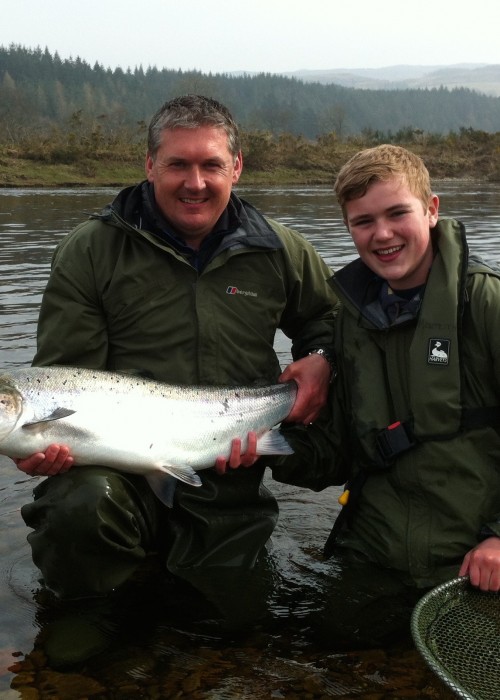
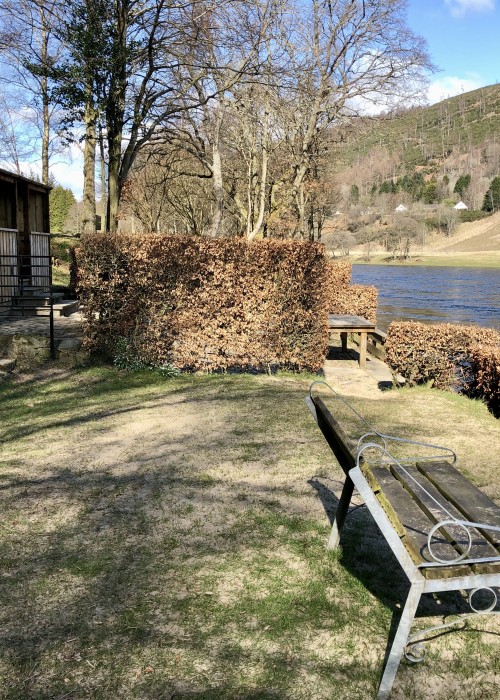
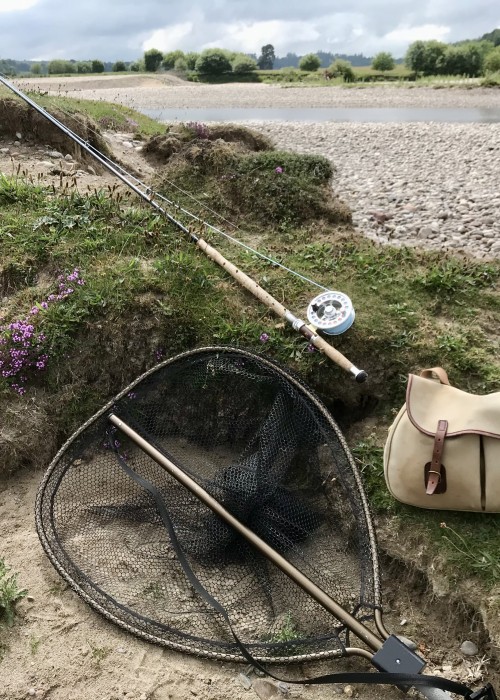
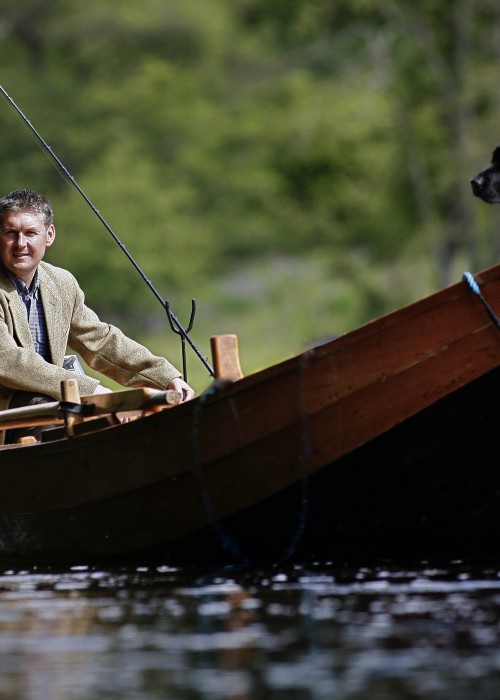
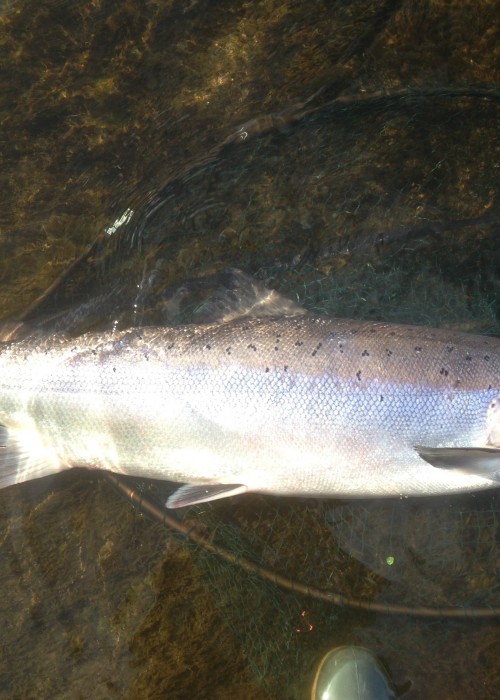

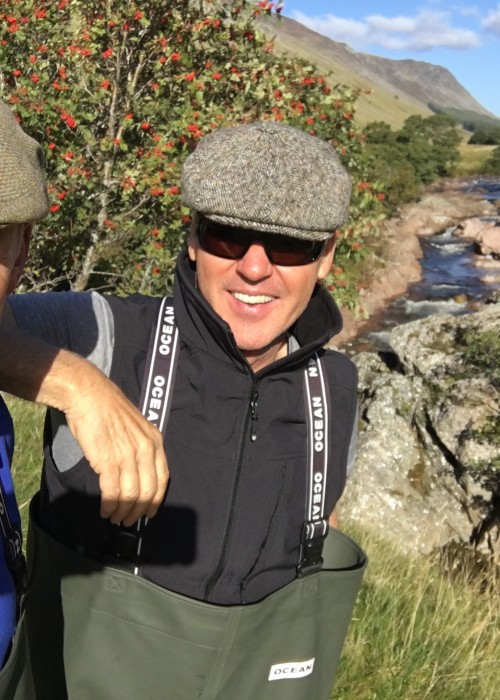
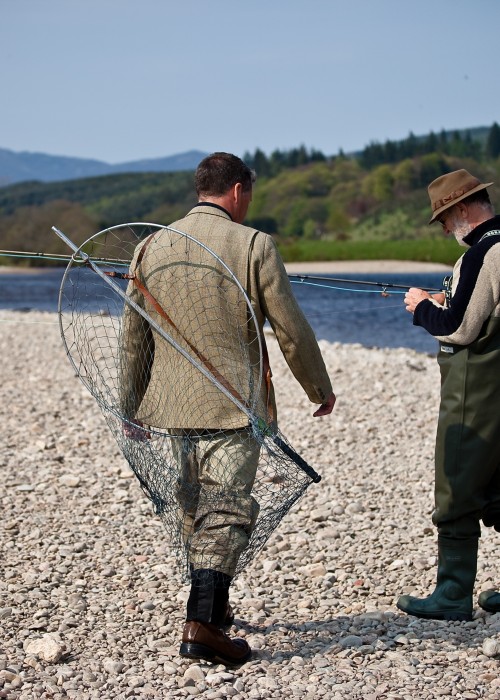
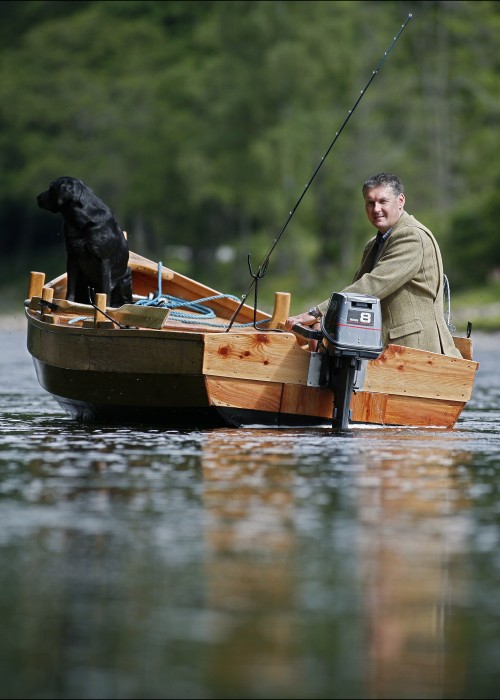
Professional Scottish ghillie Jock Monteith explains about the different salmon rivers of Scotland and provides astute tactical fishing information for success in Scottish salmon fishing.
The Atlantic salmon has the most amazing life cycle and is widely regarded as the most treasured game fish in the entire northern hemisphere and has earned the title as ‘King of Fish’. The salmon's amazing life cycle commences in the gravels of their native Scottish rivers and these spawning areas are often spread throughout the entire river system and not always up in the headwaters as many salmon enthusiasts often think. Mother Nature has split the annual salmon runs up into 3 runs of fish for each of these seasons; Spring, Summer & Autumn. The spawning season takes place through the Winter months and is triggered by the first hard frosts of the year. The salmon’s eggs are buried in the river gravels which are known as ‘redds’. During late Spring when the water temperatures rise these gravel borne salmon eggs hatch from eyed ova into small salmon fry. The salmon fry grow into salmon ‘parr’ and will stay and feed in the river as juveniles for between 2 to 3 years. After this stage of development these juvenile salmon ‘parr’ transform into smolts before heading down river to the sea. When these smolts arrive in their river's estuary these amazing little fish make the transition from fresh water to salt water before migrating northwards to the rich feeding grounds off the coasts of Greenland & the Faroes Isles. It's in the ocean where these young salmon do the bulk of their feeding and pack on bodyweight. These young salmon can stay at sea anywhere from 1 to 4 years before their reproductive instincts bring them back to their native Scottish rivers.
Scotland has over 400 hundred salmon rivers which have differing runs of salmon that appear throughout the seasons of the year. To simplify the understanding of these salmon runs it's the bigger and deeper salmon rivers that enter the North Sea on the East Coast of Scotland that attract runs of salmon from early Spring right through to late Autumn. To summarise this precisely for you the River Tay which is Scotland’s longest & largest salmon river opens early each year on the 15th of January and closes on the 15th of October. The Tay has a Spring, Summer & Autumn run of fish and is the biggest & deepest salmon river in Scotland. The later opening Aberdeenshire River Dee opens for fishing on the 1st of February and fishes through to the 30th of September. The famous River Spey commences its salmon fishing on the 11th of February each year and finishes on the 30th of September. The latest closing big Scottish East Coast river is the River Tweed in the Scottish borders which opens on the 1st of February and closes on the 30th of November each year. On the smaller shallower West Coast rivers (that are often spate dependent) it's normal for salmon only to appear during the late Summer & Autumn months so these smaller rivers have a much shorter fishing season than the big East Coast salmon rivers.
These big Scottish salmon rivers are referred to as the ‘big four’ being the Tay, Dee, Spey & Tweed and for many visitors to Scotland they represent the safest options for consistent fishable water levels due to their sheer size and depth. The Tay which is the biggest & best big river example is fed all year by many huge headwater lochs which are located in this famous Scottish salmon river’s massive catchment so even during periods of extended low rainfall the River Tay always has sufficient water for salmon to run upstream from the North sea tidal estuary located between Perth & Dundee. This knowledge is important for visiting salmon angler's to understand as the bigger Scottish rivers offer the safest prevailing water conditions if you’re planning a Scottish salmon fishing trip where as some of the smaller river can really be a hit or a miss for good water level fishing conditions.
On the smaller Scottish rivers the salmon runs arrive very occasionally during the Spring but usually after the first spates of late Summer and through the Autumn months and these rivers are much more ‘rainfall’ dependent from a fishing point of view than the bigger East Coast loch fed Scottish river systems. Famous rivers like the River Annan, River Beauly, River Brora, River Thurso, River Helmsdale, River Don, the rivers South Esk & North Esk, River Earn, River Teith, River Findhorn, River Lochay, River Conon, River Doune, River Stinchar, River Awe, River Orchy to name but a few and all share great sport each year. The same salmon run patterns exists on the West Coast Islands of Scotland of Lewis, Sky, Mull, Uist & Harris which due to the smaller shallower nature of these island rivers sees the bulk of their salmon appearing after the late Summer spates and through the Autumn months of the year. If you're timing is good and catch a falling river after a spate then sport can be prolific.
It is crucially important that when you book a Scottish salmon fishing trip you consult with a professional Scottish salmon fishing agent who knows exactly where the better managed salmon fishing venues are in Scotland that offer a good chance of sport during the duration of your fishing trip. Like most other industries there are only a few specialists who really understand the business they are in and who have the required ‘attention to detail’ and genuine career earned experience to put together a meaningful itinerary where conscientious care has been fully applied to all guest's salmon fishing trip propositions with additional well established recommendations to tried and tested local accommodation options. Follow this link for Jock Monteith's resume for reassurance you are dealing with one of Scotland's more credible and career experienced salmon fishing providers.
If you're new to salmon fishing and need to be taught quickly and effectively quickly how to fish for salmon then there's no better way to do this than to hire the professional services of a Scottish salmon fishing guide. A professional salmon fishing guide will also supply all the required salmon fishing tuition and the salmon fishing equipment in addition to the salmon fishing permit(s) access to seasonally appropriate salmon water. Our renowned professional salmon fishing guide service is available on Scotland's major salmon rivers; River Tay, River Tweed, River Spey & River Dee and is the perfect way to fast track yourself into an effective salmon fisher without the long drawn out process of being self taught.
The main differences between a personal salmon guide and a salmon beat ghillie is that a personal guide is 100% dedicated exclusively to you and your party for the entire fishing day which runs betwen 9am & 5pm. A personal guide will be able to teach you and your party how to fish for salmon and supply all of the required fishing equipment including chest waders & waterproof jackets. A Scottish salmon beat ghillie usually has the responsibility to look after all of the daily salmon fishers which are often made up of mixed parties or individual fishers. The main ghillie's roles involves 'meet & greet', issuing salmon pool fishing rotations and general fishing/fly selection advice in addition to often taking care of riverbank maintenance duties so a salmon beat ghillie is not always available to dedicate himself to tuition or personally guiding one salmon fisher (or his group) all day nor is there a guarantee that a beat ghillie (or his salmon beat) will be able to supply the required salmon fishing equipment including a full range of chest waders & waterproof jackets sizes etc.
To treat a loved one or friend who is not familiar with Scottish salmon fishing nor has the required salmon fishing equipment or fishing skills it is advisable to purchase Scottish salmon fishing gift voucher for them to ensure their quality introduction to this fascinating pursuit. The above link provides detailed information on professionally guided Scottish salmon fishing experiences on the famous rivers Tay, Spey, Dee & Tweed. A digital gift voucher can be emailed directly to you (or directly to the recipient) or alternatively a hard copy can be posted via the Royal Mail. Mutually agreeable salmon fishing date(s) can be arranged before or after the gift voucher recipient receives their guided salmon fishing experience gift voucher.
This is rarely discussed topic but is very important for consistent success in this amazing Scottish rural pursuit. In salmon fishing a stealthy approach to a salmon pool is crucial so you don't spook any fish that may be lying close to the riverbank you're about to fish down. I’ve observed many salmon anglers crunching their way over the gravel right up the side of a pool that they’re about to fish through instead of taking a more thoughtful wide berth route to the top of the pool. The first and only thing a salmon should be aware of is your fly and not any water or vibrational riverbank disturbance commotions while the angler gets into position before commencing to fish the pool. Another common error that I often observe is salmon fishers wading into a pool far too deeply with their chest waders on which will certainly spook any close lying fish to the other side of the pool making them very difficult to catch. When fishing any Scottish salmon pool it's important that you deploy some thoughtful stealth and think out your approach route before going near the fishing areas of a salmon pool.
Salmon do not feed while in the fresh water rivers of Scotland so you’re looking to trigger the salmon's hunting instincts to take your salmon fly as these fish are true prolific predators while feeding in the sea. With this fact in mind it's important that you don't show salmon too much of the fly and that you separate each swing of the fly sufficiently to not only 'startle' a salmon into taking but to also achieve good water coverage. By taking 3 good steps (1 yard) between each cast it achieves the correct fly spacing required so you’re not training a salmon to accept the presence of your fly therefore forcing the salmon to make a decision to investigate through triggering its hunting reaction instincts. On the bigger Scottish salmon rivers this 3 step per cast movement is essential for effective water coverage which if deployed over the full course of the day will significantly increase your chances of success.
Having been involved in Scottish salmon fishing since 1970 one of the most important parts of this sport is knowing exactly how to deal with setting your fly hook when a salmon takes the fly. I've witnessed great hooking opportunities to catch salmon completely blown by anglers who fail in this crucially important discipline which is seldom discussed or instructed by Scottish salmon fishing guides. My career based professional advice with salmon fly hook setting is never to lift into the take with a soft actioned salmon rod and slackly set reel clutch setting as logically there's little or no hook point pressure generated from doing so. To set a salmon fly hook effectively have the composure to wait until the initial investigatory knocks and plucks have stopped and then after several further seconds of the fly line being drawn consistently off your fly reel then simply clamp the reel with your hand firmly on the reel face to stop the line dead to feel the weight of the salmon for at least a further 3 or 4 seconds. Make sure your rod is pointing down in the direction of the fish when you do this to create direct pressure from the salmon reel to the hook point so all that is between you and the hook point is the minimal braided core stretch of your fly line. After feeling the weight of the fish and the line has locked up tight then release the reel and only then lift the rod. If this is done correctly at the correct moment into the salmon take and as detailed here your salmon will be properly hooked regardless of whether the initial micro hold of the hook point was located in soft or the tougher tissue within the salmon's mouth. This effective hooking method will allow the salmon's forward momentum & bodyweight (after it has turned on the fly and moves away in the opposite direction) to set the hook for you. Remember in warmer Summer water the salmon take will be slightly quicker than cold early Spring water take equivalent. So in the colder water of early Spring allow a few extra seconds before clamping the reel face as the low temperatures usually always means a much slower initial take.
When fishing with a spinning rod fish with a good solid initial tight clutch setting (so it takes a heavy pull to take line off the spool) and then make sure you don't slacken the clutch off to play a salmon until you're positive that you've asserted enough rod pressure to the hook points within the first 10 seconds of contact to set the hooks correctly. Setting the hooks when spinning should be done with the spinning rod by buckling straight into the fish on contact to achieve a good hook hold. When salmon take a hard spinning lure they won't hold onto it the same way salmon will with a soft salmon fly so sufficient early hook point pressure is essential to set the hooks properly. When you initially make contact with a salmon while spinning it's unlikely to do much other than momentarily (10 seconds) feel like a dead weight with a bit of movement as at this point of proceedings the salmon will not realise it has been hooked. Having spent over 10 years as a boatman on Scotland's River Tay I've seen so many salmon lost by anglers and professional ghillies with their spinning rods who all insisted on fishing a slack clutch setting similar to the way their fly reel clutches are set. All salmon fishing hooks require 'hook point pressure' to be set effectively and especially the larger hook of a spinning lure and logic should tell you that regardless of your salmon fishing experience levels. If a hook is not set quickly and effectively while spinning for salmon the fish will usually always quickly give you your lure back! There is no worse feeling in the world than the slack line following the 'adrenalin inducing' contact from an Atlantic salmon. This feeling is best avoided by listening to the above professional career-based salmon spin fishing hook set advice.
Both these above salmon hooking procedures should make good logical sense and could possibly remind you of many missed salmon hooking pportunities in the past! Once you set a hook correctly they very seldom dislodge themselves. As a professional salmon guide it's important to me that any opportunities salmon anglers work hard for while salmon fishing in Scotland are converted into 'landed salmon' and are not just lost salmon landing opportunities because no one took the time to divulge proper professional hooking information on this very important salmon fishing topic. These above fly & spinning lure salmon hooking methods are the ones I've personally used and taught to guided salmon fishing guests throughout my career which have a 95% conversion ratio as opposed to the normal non-clamping fly rod lifting & slack spinning reel clutch procedures which I've found to have a 30% effective hooking ratio by comparison.
Once you've hooked and are playing a Scottish salmon with either a salmon fly rod or a spinning rod it's important to keep the rod tip high maintaining a good fighting curve in the rod which will keep pressure on the salmon throughout the fight and will also act as a shock absorber to counteract any sudden unexpected movements from the salmon. The best riverbank fight position to get into to play a salmon is from a 'side on' position. Never allow the salmon to get below you even if it means walking a salmon down the riverbank after it to get opposite the fish. This way you are forcing the salmon to resist with a 'side on' imbalancing force as opposed to you also feeling the weight of the river if you've allowed the fish to get into an incorrect downstream position. When you're playing the salmon you should be scanning for an appropriate landing area for the final stages of the fight where there's ideally deep calm water with no obvious signs of snags or riverbed obstructions. Never ever try to play a salmon in fast water as it will use the higher water pressure to its advantage so always look for the calmer areas of the pool to steer the fish to and play a salmon in. You should never rush the fight or attempt to land the salmon too soon and you should always wait until the fish starts to show signs of tiring which will be easily observed by its slower movements at close range and the fish starting to show its flanks and tail. When the time is right place the salmon landing net down in the water and in one steady movement draw the salmon over the sunken net and simply lift the net. Unhooking the salmon should be done in the landing net in the water to avoid injury to the fish prior to releasing the fish.
Once you've landed your salmon keep the salmon in the landing net when taking a photograph and make sue you get the fish properly in frame ideally on its side to capture the beauty of the salmon's flanks and proportions. If you're fishing with a colleague have them take a shot with you holding the salmon in the landing net. If you hold the mesh bag you can fairly easily lift the fish to the waterline and tilt the salmon's flanks up towards the camera lens which creates a great capture shot. A photograph of your salmon makes a nice memento of the encounter and also for the salmon beat's records so a camera should be carried at all times. Be aware of the sun's position in the sky if it's a brighter day and if so position the sun behind the camera and try to include in the shot the pool where the salmon was caught in the background with some of the riverbank. Do do this will likely involve the cameraman crouching down to capture the back drop too. It's also a good idea to make sure you camera or phone camera is carried in a waterproof bag to keep it safe from water penetration.
Here are a few good examples of some of the best Scottish salmon fishing venues to give an insight into the river beauty and geographical location of what Scottish salmon fishing has to offer;
Dalmarnock is a true gem on an extensive River Tay salmon beat that spans some 2.5 miles of prime middle Tay moxed fly & spin fishing water. This Tay beat is a delight to fish. Follow this link for more details on Dalmarnock salmon fishing.
Lower Kinnaird is another popular middle Tay salmon beat and is always worthy of a visit such is the beauty of its meandering pool formations. Click this link for more details on Lower Kinnaird salmon fishing.
The Upper Kinnaird salmon beat of the middle Tay has a fascinating blend of high water/low water salmon fishing on the River Tay. Click this link for more details on Upper Kinnaird salmon fishing.
The Lower Tummel salmon pools are typical of the fantastic flows of this perfect River Tay tributary river which offers high quality Spring fishing each year. Follow this link for more information on Lower Tummel salmon fishing.
The beautiful Crathie beat is positioned in the upper River Dee catchment between the Royal Deeside towns of Banchory & Ballater. This 9 mile stretch of the famous River Dee commences near Balmoral Castle and makes the Crathie salmon fishing beat one of the very best River Dee Autumn salmon fishing venues.
Invery & Tilquhillie is a fantastic middle River Dee salmon fishing venue within a stone's throw of the popular Aberdeenshire town of Banchory. Click this link for more details on Invery and Tilquhillie salmon fishing.
The Banchory Beat of the River Dee has some of the very finest middle Dee salmon holding water on it due to the confluence of the River Feugh which enters the Dee here. Follow this link for more detailed information on the Banchory salmon fishing beat of the River Dee.
As mentioned many times in this Scottish salmon fishing guide the best most effective way to book salmon fishing in Scotland is to hire a professional salmon guide for your fishing trip. A professional guide will not only supply all of the required salmon fishing equipment but will also teach you the important salmon fishing skills in addition to arranging an appropriate salmon fishing location. This service is particularly useful if you're new to Scottish salmon fishing or have experienced minimal success as an existing salmon fisher and are in need of tactical fine tuning. Follow this link for details of our guided salmon fishing packages on Scotland's 4 major salmon rivers.